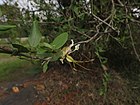Note: This is a project under development. The articles on this wiki are just being initiated and broadly incomplete. You can Help creating new pages.
Cadaba fruticosa
Cadaba farinosa is a slender, evergreen woody plant. It grows up to 5 metres tall. It has a strongly furrowed stem, rarely straight, with a yellowish grey bark. A food made using the leaves of this plant is sold in local markets. The plant also has medicinal uses and is planted for soil stabilization.
Contents
- 1 Uses
- 2 Parts Used
- 3 Chemical Composition
- 4 Common names
- 5 Properties
- 6 Habit
- 7 Identification
- 8 List of Ayurvedic medicine in which the herb is used
- 9 Where to get the saplings
- 10 Mode of Propagation
- 11 How to plant/cultivate
- 12 Commonly seen growing in areas
- 13 Photo Gallery
- 14 References
- 15 External Links
Uses
Dysentery, Colds, Various internal disorders, Dermatological conditions, Anthrax.
Parts Used
Chemical Composition
Common names
| Language | Common name |
|---|---|
| Kannada | ಮರಗಾಡೆ ಗಿಡ Maragade gida |
| Hindi | Dabi, Kodhab |
| Malayalam | Kattakatti, Viluti |
| Tamil | Uru-vara-c-camatti |
| Telugu | Aadamorinika |
| Marathi | Habab |
| Gujarathi | Kalo katakiyo |
| Punjabi | |
| Kashmiri | |
| Sanskrit | |
| English | Indian cadaba |
Properties
Reference: Dravya - Substance, Rasa - Taste, Guna - Qualities, Veerya - Potency, Vipaka - Post-digesion effect, Karma - Pharmacological activity, Prabhava - Therepeutics.
Dravya
Rasa
Guna
Veerya
Vipaka
Karma
Prabhava
Habit
Identification
Leaf
| Kind | Shape | Feature |
|---|---|---|
Flower
| Type | Size | Color and composition | Stamen | More information |
|---|---|---|---|---|
| {{{5}}} |
Fruit
| Type | Size | Mass | Appearance | Seeds | More information |
|---|---|---|---|---|---|
Other features
List of Ayurvedic medicine in which the herb is used
Where to get the saplings
Mode of Propagation
How to plant/cultivate
Succeeds in tropical and subtropical areas at altitudes from sea level to 1,600 metres.[4]
Commonly seen growing in areas
Common in large depressions, Sandy silts of valleys, Around temporary ponds, Stabilized dunes, Termite mounds.
Photo Gallery
References
- ↑ [Chemistry]
- ↑ Common names
- ↑ [Morphology]
- ↑ Cultivation
External Links
- Ayurvedic Herbs known to be helpful to treat Dysentery
- Ayurvedic Herbs known to be helpful to treat Colds
- Ayurvedic Herbs known to be helpful to treat Various internal disorders
- Ayurvedic Herbs known to be helpful to treat Dermatological conditions
- Ayurvedic Herbs known to be helpful to treat Anthrax
- Herbs with Young leaves used in medicine
- Herbs with Flowers used in medicine
- Herbs with common name in Kannada
- Herbs with common name in Hindi
- Herbs with common name in Malayalam
- Herbs with common name in Tamil
- Herbs with common name in Telugu
- Herbs with common name in Marathi
- Herbs with common name in Gujarathi
- Herbs with common name in English
- Habit - Evergreen shrub
- Index of Plants which can be propagated by Seeds
- Herbs that are commonly seen in the region of Common in large depressions
- Herbs that are commonly seen in the region of Sandy silts of valleys
- Herbs that are commonly seen in the region of Around temporary ponds
- Herbs that are commonly seen in the region of Stabilized dunes
- Herbs that are commonly seen in the region of Termite mounds
- Herbs
- Pages without herbs images





